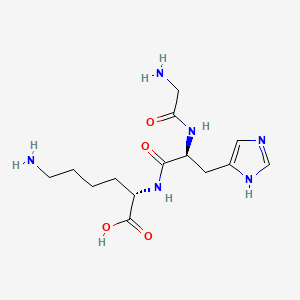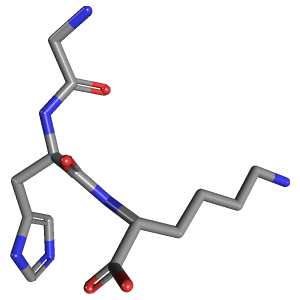Glycyl-L-Histidyl-L-Lysine Information
Click here to view all Glycyl-L-Histidyl-L-Lysine productsThe information, including but not limited to, text, graphics, images and other material contained on this website are for informational purposes only. No material on this site is intended to be a substitute for the consultation, diagnosis, and/or medical treatment of a qualified physician or healthcare provider.


Glycyl-L-Histidyl-L-Lysine (GHK) is a naturally occurring human tripeptide, meaning it's a small protein fragment made up of three amino acids: Glycine, L-Histidine, and L-Lysine, joined in that specific sequence (Gly-His-Lys).
It is found in human plasma, saliva, and urine, but its concentration in the plasma declines significantly with age. GHK is particularly well-known for its strong affinity for copper ions, with which it readily forms a complex known as GHK-Cu or Copper Peptide. This copper-peptide complex is the active form used in most research and commercial products, especially in skincare and wound healing.
Glycyl-L-Histidyl-L-Lysine (GHK) is a naturally occurring human tripeptide, meaning it's a small protein fragment made up of three amino acids: Glycine, L-Histidine, and L-Lysine, joined in that specific sequence (Gly-His-Lys).
It is found in human plasma, saliva, and urine, but its concentration in the plasma declines significantly with age. GHK is particularly well-known for its strong affinity for copper ions, with which it readily forms a complex known as GHK-Cu or Copper Peptide. This copper-peptide complex is the active form used in most research and commercial products, especially in skincare and wound healing.
How Glycyl-L-Histidyl-L-Lysine (GHK-Cu) Works?
The mechanism of action for GHK, particularly when complexed with copper (GHK-Cu), is multi-faceted and primarily involves regulating cellular and genetic activity, especially those related to tissue repair, anti-aging, and anti-inflammation.
1. Copper Delivery and Regulation
The primary function of GHK is thought to be the delivery and regulation of copper ions to cells and tissues.7 Copper is an essential micronutrient and cofactor for many enzymes involved in crucial biological processes, including:
-
Collagen and Elastin Synthesis: Copper is required for the enzyme lysyl oxidase, which cross-links collagen and elastin fibers, providing strength and elasticity to tissues like the skin.
-
Antioxidant Defense: Copper is a cofactor for the antioxidant enzyme superoxide dismutase (SOD).
2. Tissue Remodeling and Regeneration
GHK-Cu accelerates tissue repair and remodeling in various tissues (skin, hair follicles, bone, etc.) by:
-
Stimulating Production: It stimulates the synthesis of key extracellular matrix components like collagen, elastin, and glycosaminoglycans (e.g., hyaluronic acid, which help keep tissue hydrated).
-
Modulating Enzymes: It helps to modulate the activity of matrix metalloproteinases (MMPs) (which break down proteins) and their inhibitors (TIMPs), suggesting a role in controlling both the breakdown of damaged tissue and the formation of new, healthy tissue.
-
Angiogenesis: It promotes angiogenesis (the formation of new blood vessels) and nerve outgrowth, which are vital for healing and tissue health.
3. Anti-Inflammatory and Antioxidant Effects
GHK-Cu has powerful protective effects:
-
Antioxidant Activity: It acts as an antioxidant, helping to neutralize harmful reactive oxygen species (ROS) and reduce oxidative stress, which contributes to aging and tissue damage.
-
Anti-inflammatory Effects: It demonstrates anti-inflammatory actions, suppressing the release of pro-inflammatory cytokines, which helps calm and repair damaged skin and tissues.
4. Gene Modulation
Recent research suggests one of the most significant mechanisms is its ability to modulate the expression of a large number of human genes (potentially thousands). This gene modulation essentially helps to reset gene expression patterns from a damaged or aged state back to a healthier, more youthful state, influencing various biological pathways related to cell survival, anti-cancer activity, and tissue repair.
Synonyms of Glycyl-L-Histidyl-L-Lysine
- glycyl-l-histidyl-l-lysine
- 49557-75-7
- Prezatide
- Glycyl-histidyl-lysine
- Liver cell growth factor
- Copper(II)ghk
- KOLLAREN
- ORISTAR GHK
- Growth-modulating peptide (human)
- 39TG2H631E
- PC-1020 FREE BASE
- DTXSID30197831
- NSC-379527
- N(2)-(N-Glycyl-L-histidyl)-L-lysine
- Natural Cedarwood Oil
- RefChem:868497
- Seacall Natural Cedarwood Oil
- DTXCID90120322
- Gly-his-lys
- L-Lysine, glycyl-L-histidyl-
- Tripeptide-1
- GHK-Cu
- MFCD00036754
- NSC 379527
- (S)-6-Amino-2-((S)-2-(2-aminoacetamido)-3-(1H-imidazol-4-yl)propanamido)hexanoic acid
- C14H24N6O4
- CHEMBL1814493
- CHEBI:75430
- Copper Peptide
- ghk
- Gly-His-Lys acetate salt
- H-Gly-His-Lys-OH
- Copper glycyl-histidyl-lysine
- UNII-39TG2H631E
- NSC379527
- Copper Peptide(GHK-Cu, GHK-Copper)
- Tripeptide-1/GHK
- Gly-L-His-L-Lys
- GLY-HIS-LYS-OH
- GHK [MI]
- (2S)-6-amino-2-[[(2S)-2-[(2-aminoacetyl)amino]-3-(1H-imidazol-5-yl)propanoyl]amino]hexanoic acid
- SCHEMBL259085
- C.P.P.
- orb1302801
- SCHEMBL19087235
- GLXC-23067
- EX-A7713
- HY-P0046
- BDBM50350478
- AKOS016003505
- AKOS040758595
- DB11296
- 1227510-36-2
- AC-31946
- BG162807
- BP-41196
- DA-72333
- DS-14630
- SY041831
- CS-0005654
- NS00070865
- I10329
- 557G757
- F045580
- Glycyl-L-Histidyl-L-Lysine (H-Gly-L-His-L-Lys-OH)
- (2S)-6-amino-2-[(2S)-2-(2-aminoacetamido)-3-(1H-imidazol-5-yl)propanamido]hexanoic acid
- (2S)-6-amino-2-[[(2S)-2-[(2-aminoacetyl)amino]-3-(1H-imidazol-4-yl)propanoyl]amino]hexanoic acid
External Sources about Glycyl-L-Histidyl-L-Lysine
- glycyl-L-histidyl-L-lysine | C14H24N6O4 | CID 73587 - PubChem
- Glycyl-L-histidyl-L-lysine (GHK) | Tripeptide - MedchemExpress.com
- What are the uses and potential benefits of GHK (Glycyl-Histidyl-Lysine) peptide in wound healing and tissue repair? - Dr.Oracle
- Regenerative and Protective Actions of the GHK-Cu Peptide in the Light of the New Gene Data - NIH
- GHK Peptide as a Natural Modulator of Multiple Cellular Pathways in Skin Regeneration
- Copper peptide GHK-Cu - Wikipedia
- GHK-Cu may Prevent Oxidative Stress in Skin by Regulating Copper and Modifying Expression of Numerous Antioxidant Genes - MDPI
- The Human Tripeptide GHK (Glycyl-L-Histidyl-L-Lysine), The Copper Switch, and The Treatment of the Degenerative Conditions of Aging | Request PDF - ResearchGate

